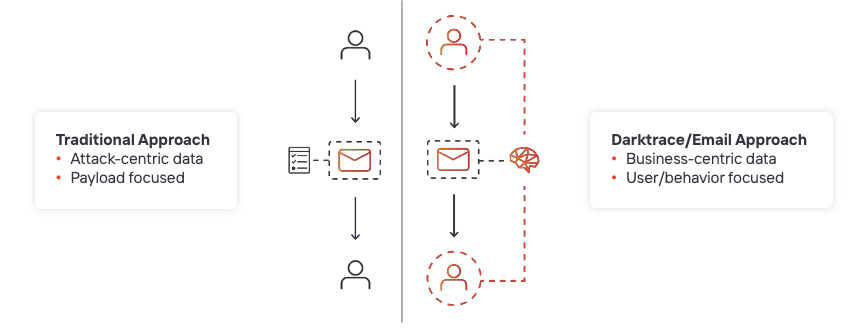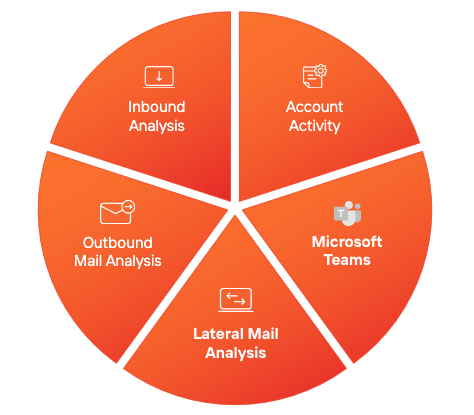Organizations Should Demand More from their Email Security
In response to a more intricate threat landscape, organizations should view email security as a critical component of their defense-in-depth strategy, rather than defending the inbox alone with a traditional Secure Email Gateway (SEG). Organizations need more than a traditional gateway – that doubles, instead of replaces, the capabilities provided by native security vendor – and require an equally granular degree of analysis across all messaging, including inbound, outbound, and lateral mail, plus Teams messages.
Darktrace/Email is the industry’s most advanced cloud email security, powered by Self-Learning AI. It combines AI techniques to exceed the accuracy and efficiency of leading security solutions, and is the only security built to elevate, not duplicate, native email security.
With its largest update ever, Darktrace/Email introduces the following innovations, finally allowing security teams to look beyond secure email gateways with autonomous AI:
- AI-augmented data loss prevention to stop the entire spectrum of outbound mail threats
- an easy way to deploy DMARC quickly with AI
- major enhancements to streamline SOC workflows and increase the detection of sophisticated phishing links
- expansion of Darktrace’s leading AI prevention to lateral mail, account compromise and Microsoft Teams
What’s New with Darktrace/Email
Data Loss Prevention
Block the entire spectrum of outbound mail threats with advanced data loss prevention that builds on tags in native email to stop unknown, accidental, and malicious data loss
Darktrace understands normal at individual user, group and organization level with a proven AI that detects abnormal user behavior and dynamic content changes. Using this understanding, Darktrace/Email actions outbound emails to stop unknown, accidental and malicious data loss.
Traditional DLP solutions only take into account classified data, which relies on the manual input of labelling each data piece, or creating rules to catch pattern matches that try to stop data of certain types leaving the organization. But in today’s world of constantly changing data, regular expression and fingerprinting detection are no longer enough.

- Human error – Because it understands normal for every user, Darktrace/Email can recognize cases of misdirected emails. Even if the data is correctly labelled or insensitive, Darktrace recognizes when the context in which it is being sent could be a case of data loss and warns the user.
- Unclassified data – Whereas traditional DLP solutions can only take action on classified data, Darktrace analyzes the range of data that is either pending labels or can’t be labeled with typical capabilities due to its understanding of the content and context of every email.
- Insider threat – If a malicious actor has compromised an account, data exfiltration may still be attempted on encrypted, intellectual property, or other forms of unlabelled data to avoid detection. Darktrace analyses user behaviour to catch cases of unusual data exfiltration from individual accounts.
And classification efforts already in place aren’t wasted – Darktrace/Email extends Microsoft Purview policies and sensitivity labels to avoid duplicate workflows for the security team, combining the best of both approaches to ensure organizations maintain control and visibility over their data.
End User and Security Workflows
Achieve more than 60% improvement in the quality of end-user phishing reports and detection of sophisticated malicious weblinks1
Darktrace/Email improves end-user reporting from the ground up to save security team resource. Employees will always be on the front line of email security – while other solutions assume that end-user reporting is automatically of poor quality, Darktrace prioritizes improving users’ security awareness to increase the quality of end-user reporting from day one.
Users are empowered to assess and report suspicious activity with contextual banners and Cyber AI Analyst generated narratives for potentially suspicious emails, resulting in 60% fewer benign emails reported.
Out of the higher-quality emails that end up being reported, the next step is to reduce the amount of emails that reach the SOC. Darktrace/Email’s Mailbox Security Assistant automates their triage with secondary analysis combining additional behavioral signals – using x20 more metrics than previously – with advanced link analysis to detect 70% more sophisticated malicious phishing links.2 This directly alleviates the burden of manual triage for security analysts.
For the emails that are received by the SOC, Darktrace/Email uses automation to reduce time spent investigating per incident. With live inbox view, security teams gain access to a centralized platform that combines intuitive search capabilities, Cyber AI Analyst reports, and mobile application access. Analysts can take remediation actions from within Darktrace/Email, eliminating console hopping and accelerating incident response.

Microsoft Teams
Detect threats within your Teams environment such as account compromise, phishing, malware and data loss
Around 83% of Fortune 500 companies rely on Microsoft Office products and services, particularly Teams and SharePoint.3
Darktrace now leverages the same behavioral AI techniques for Microsoft customers across 365 and Teams, allowing organizations to detect threats and signals of account compromise within their Teams environment including social engineering, malware and data loss.
The primary use case for Microsoft Teams protection is as a potential entry vector. While messaging has traditionally been internal only, as organizations open up it is becoming an entry vector which needs to be treated with the same level of caution as email. That’s why we’re bringing our proven AI approach to Microsoft Teams, that understands the user behind the message.
Anomalous messaging behavior is also a highly relevant indicator of whether a user has been compromised. Unlike other solutions that analyze Microsoft Teams content which focus on payloads, Darktrace goes beyond basic link and sandbox analysis and looks at actual user behavior from both a content and context perspective. This linguistic understanding isn’t bound by the requirement to match a signature to a malicious payload, rather it looks at the context in which the message has been delivered. From this analysis, Darktrace can spot the early symptoms of account compromise such as early-stage social engineering before a payload is delivered.
Lateral Mail Analysis
Detect and respond to internal mailflow with multi-layered AI to prevent account takeover, lateral phishing and data leaks
The industry’s most robust account takeover protection now prevents lateral mail account compromise. Darktrace has always looked at internal mail to inform inbound and outbound decisions, but will now elevate suspicious lateral mail behaviour using the same AI techniques for inbound, outbound and Teams analysis.

Unlike other solutions which only analyze payloads, Darktrace analyzes a whole range of signals to catch lateral movement before a payload is delivered. Contributing yet another layer to the AI behavioral profile for each user, security teams can now use signals from lateral mail to spot the early symptoms of account takeover and take autonomous actions to prevent further compromise.
DMARC
Gain in-depth visibility and control of 3rd parties using your domain with an industry-first AI-assisted DMARC
Darktrace has created the easiest path to brand protection and compliance with the new Darktrace/DMARC. This new capability continuously stops spoofing and phishing from the enterprise domain, while automatically enhancing email security and reducing the attack surface.
Darktrace/DMARC helps to upskill businesses by providing step by step guidance and automated record suggestions provide a clear, efficient road to enforcement. It allows organizations to quickly achieve compliance with requirements from Google, Yahoo, and others, to ensure that their emails are reaching mailboxes.
Meanwhile, Darktrace/DMARC helps to reduce the overall attack surface by providing visibility over shadow-IT and third-party vendors sending on behalf of an organization’s brand, while informing recipients when emails from their domains are sent from un-authenticated DMARC source.
Darktrace/DMARC integrates with the wider Darktrace product platform, sharing insights to help further secure your business across Email Attack Path and Attack Surface management.
Conclusion
To learn more about the new innovations to Darktrace/Email download the solution brief here.
All of the new updates to Darktrace/Email sit within the new Darktrace ActiveAI Security Platform, creating a feedback loop between email security and the rest of the digital estate for better protection. Click to read more about the Darktrace ActiveAI Security Platform or to hear about the latest innovations to Darktrace/OT, the most comprehensive prevention, detection, and response solution purpose built for critical infrastructures.
Learn about the intersection of cyber and AI by downloading the State of AI Cyber Security 2024 report to discover global findings that may surprise you, insights from security leaders, and recommendations for addressing today’s top challenges that you may face, too.
References
[1] Internal Darktrace Research
[2] Internal Darktrace Research
[3] Essential Microsoft Office Statistics in 2024


































.jpg)

.jpg)




